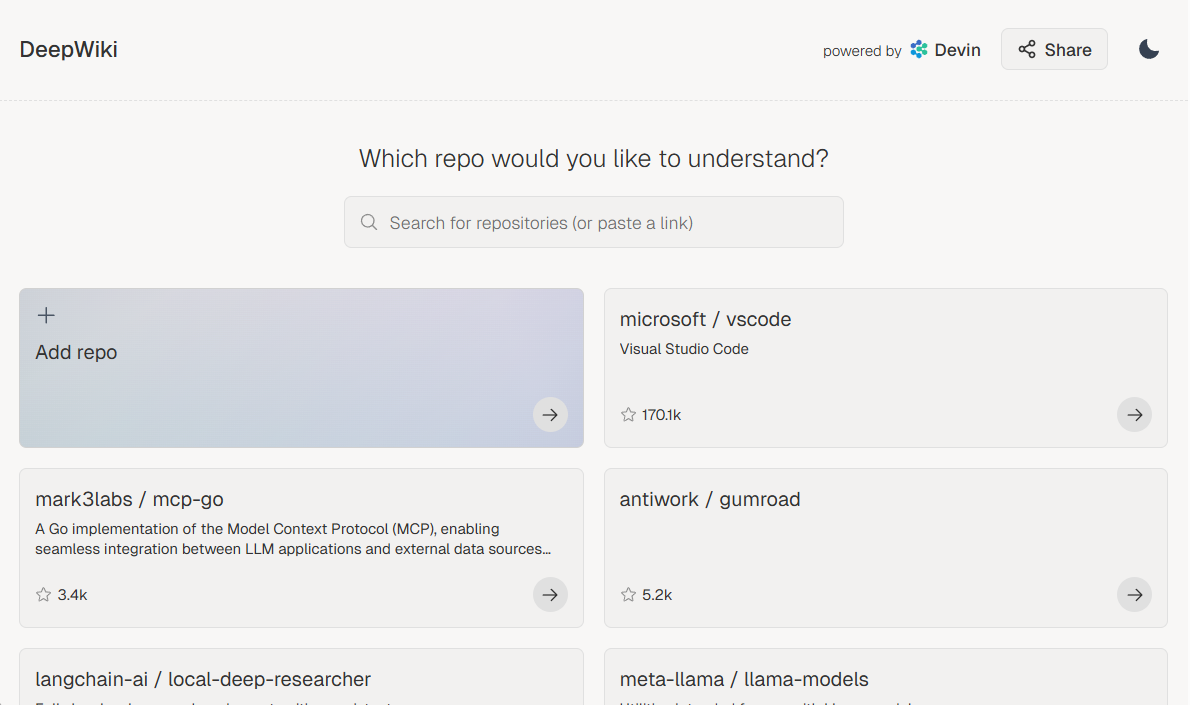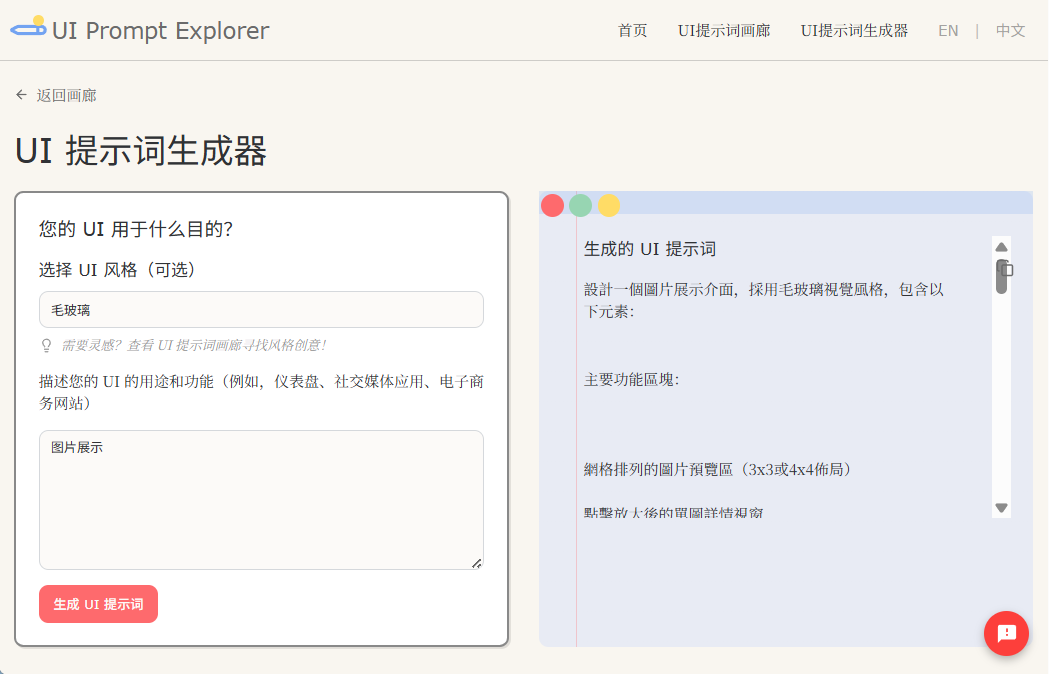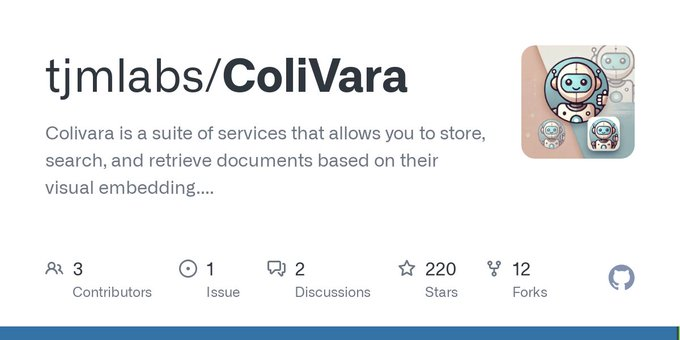DeepWiki: Automatically Generate GitHub Repository Documentation and Talk to It with AI
General Introduction
DeepWiki is a free tool from Cognition AI focused on generating structured, Wikipedia-like documentation for GitHub repositories. It helps developers quickly understand complex code bases by analyzing code, README files, and configuration files to automatically create detailed documentation and interactive diagrams. Users simply replace "github" with "deepwiki" in the URL of their GitHub repository to access the generated documentation page. With support for more than 30,000 repositories covering 4 billion lines of code, the tool is particularly well suited to open-source projects. deepWiki also offers AI conversations, allowing users to ask questions in natural language to get code-related answers. It requires no installation, is simple to use, and greatly improves development efficiency.

Function List
- Automatic Documentation Generation: Analyze code, READMEs, and configuration files from GitHub repositories to generate structured wiki-style documentation.
- Interactive Diagrams: Provides visual diagrams of the code architecture, showing the relationships between files, functions and modules.
- AI Dialog Assistant: Supports natural language questioning to answer questions about code functionality, structure, or dependencies.
- Rapid document scanning: instantly analyzes the contents of the warehouse and provides an overview of core functionality.
- Deep research mode: in-depth analysis of the code base to identify potential problems or optimization recommendations.
- Multi-language support: Compatible with JavaScript, Python, Go, Rust, Java and other programming languages.
- Free Access: Public Warehouse document generation is completely free and requires no registration.
Using Help
How to use DeepWiki
DeepWiki is very easy to use and does not require any software to be installed. Here are the steps to do it:
- Visit the DeepWiki website
Open your browser and typehttps://deepwiki.com/The first page displays a search box and a list of popular GitHub repositories. The homepage displays a search box and a list of popular GitHub repositories, such as React, TensorFlow, and so on. Users can click on the repositories they are interested in to view the generated documentation. - Accessing repository documentation via URL
- Find the URL of the target GitHub repository, for example
https://github.com/user/repoThe - Replace "github" with "deepwiki" in the URL to read
https://deepwiki.com/user/repoThe - Press Enter and DeepWiki will automatically analyze the repository and generate a documentation page.
- If the repository has not yet been indexed, the page will prompt for an email address. Once submitted, DeepWiki will index and generate the document within a few minutes.
- Find the URL of the target GitHub repository, for example
- Using the search box
Enter the path to your GitHub repository in the search box on the DeepWiki home page (e.g.microsoft/vscodemaybelangchain-ai/langchain). After clicking Search, the system will jump to the documentation page of the corresponding warehouse. - Add private repository (registration required)
- For private repositories, users need to register for an account on the DeepWiki website and log in.
- Click the "Add repo" button on the home page and enter the path to the repository (e.g.
TryGhost/Ghost) or the full URL. - To access a private repository, you need to provide a personal access token for GitHub or GitLab. Tokens can be generated in GitHub under "Settings > Developer settings > Personal access tokens".
- After submission, DeepWiki analyzes the private repository and generates documentation.
Featured Functions Operation Procedure
Automatic Document Generation
DeepWiki generates detailed documentation by analyzing the repository's code structure, README and configuration files. The documentation includes:
- Code Structure Overview: Lists the main files and directories of the repository, describing what each module does.
- Functional Description: Describe the function of key functions, classes, and variables, and explain complex logic in layman's terms.
- dependency analysis: List the external libraries and frameworks used by the project, describing their purpose.
Users can browse this content directly after opening the document page. Documentation pages are clearly laid out, usually with directory navigation on the left and detailed content on the right.
Interactive Charts
DeepWiki's diagramming feature shows the architecture of the codebase through visualization. Diagrams are included:
- Documentation Relationship Diagram: Shows the calling relationships between files.
- Module Dependency Diagram: Show dependencies and interactions between modules.
- control flow chart: Describes the execution path of the code.
Diagrams can be viewed by clicking on "Diagrams" or similar tabs on the documentation page. Some of the diagrams support interaction, such as clicking on a node to jump to the corresponding code segment.
AI Dialog Assistant
DeepWiki provides an easy-to-use, easy-to-use, and easy-to-use tool based on the Devin AI's conversational assistant. The procedure is as follows:
- Find the input box at the bottom of the documentation page (usually labeled "Ask about this repo").
- Enter a question, such as "What does this function do?" or "How is the project configured for the database?" or "How does the project configure the database?" .
- Upon submission, the AI generates contextually relevant answers based on the contents of the repository.
- Users can continue to ask questions and the AI will keep the conversation going and provide more in-depth answers.
In-depth research model
The Deep Research mode is for users who need advanced analysis. Method of Operation:
- Find the "Deep Research" switch on the documentation page (it may be located near the search box).
- Once opened, enter complex questions such as "What are the performance bottlenecks in this repository?" or "What are the potential bugs in the code? or "What are the potential bugs in the code?".
- DeepWiki performs multiple rounds of analysis and generates a detailed report with problem descriptions, code snippets, and optimization recommendations.
caveat
- public warehouse: Free to use without registration.
- Private Warehouse: Registration and an access token are required, and it is recommended that the token be kept in a safe place.
- large warehouse: The analysis may take a few minutes and it is recommended to start with a small warehouse to try it out.
- Language Support: DeepWiki supports mainstream programming languages, but support for unconventional languages may be limited.
application scenario
- Quick start program for new developers
Developers new to a project often spend days reading code and documentation, and DeepWiki generates documentation and diagrams to help them quickly understand the project's architecture and core functionality. For example, a front-end developer can use DeepWiki to learn about React The component structure of the project saves learning time. - Open Source Project Contribution
Open source contributors are often discouraged by unfamiliarity with the codebase, and DeepWiki provides detailed documentation and AI answers that allow contributors to quickly find modules that can be improved. For example, contributors can ask "What are the outstanding issues in this repository?" and directly locate the relevant code. - Technical interview preparation
Candidates can use DeepWiki to analyze a target company's open source projects and learn about its technology stack and code practices. For example, a back-end developer candidate can study the API design of a company's repository to prepare for interview questions. - Students learn to program
Beginning programmers can use DeepWiki to learn about code implementations of well-known open source projects. For example, students can analyze the documentation of TensorFlow and combine it with AI assistant answers to understand the principles of machine learning frameworks.
QA
- What programming languages does DeepWiki support?
DeepWiki supports JavaScript, Python, Go, Rust, Java and other mainstream languages, covering most development areas. For non-conventional languages, documentation generation may not be complete. - How do private repositories use DeepWiki?
Register for an account and provide a personal access token for GitHub or GitLab. Once logged in, enter the path to your private repository and DeepWiki will generate documentation. - Are the generated documents accurate?
DeepWiki's documentation is based on AI analysis and is usually accurate, but complex or insufficiently commented code can lead to interpretation bias. Combined with source code validation is recommended. - Is DeepWiki completely free?
Documentation generation in the public repository is completely free of charge. Private repositories require registration, and some advanced features may require payment (visit the official website to confirm the exact price).
© Copyright notes
Article copyright AI Sharing Circle All, please do not reproduce without permission.
Related posts

No comments...




